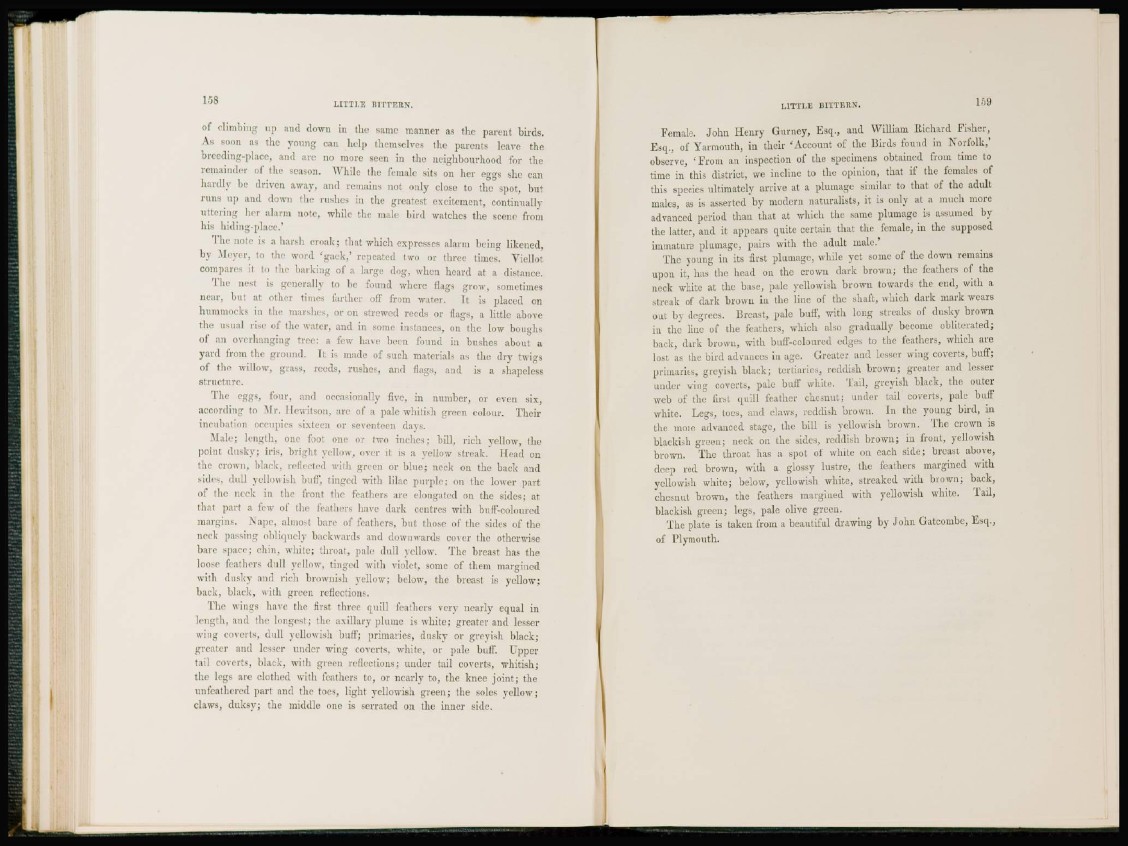
158 LITTLE LSTTTERN.
of climbing up and down in the same manner as the parent birds.
As soon as the young can help themselves ihc parents leave the
breeding-place, and are no more seen in the neighbourhood for the
remainder of the season. While the female sits on her eggs she can
hardly be driven away, and remains not only close to the spot, but
runs up and down the rushes in the greatest excitement, continuallv
uttcring her alarm note, while the male bird watches the scene from
his hiding-place,'
The note is a harsh croak; that which expresses alarm being likened,
by Meyer, to the word 'gaek,' repeated two or three times. Viellot
compares ii to the harking of a large dog, when heard at a distance.
The nest is generally to he found where flags grow, sometimes
near, but at other times farther off from water. It is placed on
hummocks in the marshes, or on strewed reeds or flags, a little above
the usual rise of the water, and in some instances, on the low boughs
of an overhanging tree: a feu- have been found in bushes about a
yard from the ground. It is made of such materials as the dry twigs
of the willow, grass, reeds, rushes, and flags, and is a shapeless
structure.
The eggs, four, and occasionally five, in number, or even six,
according to Mr. Ilewitson, arc of a pale whitish green colour. Their
incubation occupies sixteen or seventeen days.
Male; length, one foot one or two inches; bill, rich yellow, the
point dusky; iris, bright yellow, over it is a yellow streak. Head on
the crown, black, reflected with green or blue; neck on the back and
sides, dull yellowish buff, tinged with lilac purple; on the lower part
of the neck in the front the feathers are elongated on the sides; at
that part a few of the feathers have dark centres with buff-coloured
margins. Nape, almost bare of feathers, hut those of the sides of the
neck passing obliquely backwards and downwards cover the otherwise
bare space; chin, white; throat, pale dull yellow. The breast has the
loose feathers dull yellow, tinged with violet, some of them margined
with dusky and rich brownish yellow; below, the breast is yellow;
back, black, with green reflections.
The wings have the first three quill feathers very nearly equal in
length, and the longest; the axillary plume is white; greater and lesser
wing coverts, dull yellowish buff; primaries, dusky or greyish black;
greater and lesser under wing coverts, w'hite, or pale buff. Upper
tail coverts, black, with green reflections; under tail coverts, whitish;
the legs are clothed with feathers to, or nearly to, the knee joint; the
unfeathered part and the toes, light yellowish green; the soles yellow;
claws, duksy; the middle one is serrated on the inner side.
LITTLE BITTERS. 159
Female. John Henry Gurney, Esq., and William Richard Fisher,
Esq., of Yarmouth, in their 'Account of the Birds found in Norfolk,'
observe, ' F r om an inspection of the specimens obtained from time to
time in this district, we incline to the opinion, that if the females of
this species ultimately arrive at a plumage similar to that of the adult
males, as is asserted by modern naturalists, it is only at a much more
advanced period than that at which the same plumage is assumed by
the latter, and it appears quite certain that the female, in the supposed
immature plumage, pairs with the adult male.'
The young in its first plumage, while yet some of the down remains
upou it, has the head on the crown dark brown; the feathers of the
neck white at the base, pale yellowish brown towards the end, with a
streak of dark brown in the line of the shaft, which dark mark wears
out by degrees. Breast, pale buff, witli long streaks of dusky brown
in the line of the feathers, which also gradually become obliterated;
back, dark brown, with buff-coloured edges to the feathers, which are
lost as the bird advances in age. Greater and lessor wing coverts, buff;
primaries, greyish black; tcrtiaries, reddish brown; greater and lesser
under wing coverts, pale bull* white. Tail, greyish black, the outer
web of the first quill feather chesnut; under tail coverts, pale buff
white. Legs, toes, and claws, reddish brown. In the young bird, in
the more advanced stage, the bill is yellowish brown. The crown is
blackish green; neck on the sides, reddish brown; in front, yellowish
brown. The throat has a spot of white on each side; breast above,
deep red brown, with a glossy lustre, the feathers margined with
yellowish white; below, yellowish white, streaked with brown; back,
chesnut brown, the feathers margined with yellowish wdiite. Tail,
blackish green; legs, pale olive green.
The plate is taken from a beautiful drawing by John Gatcombe, Esq.,
of Plymouth.